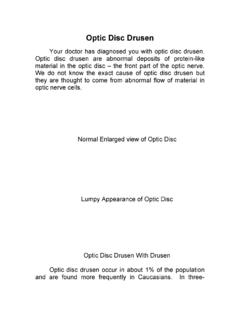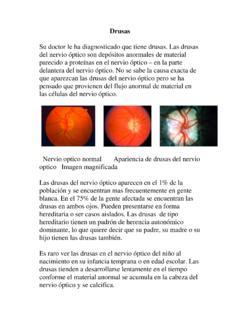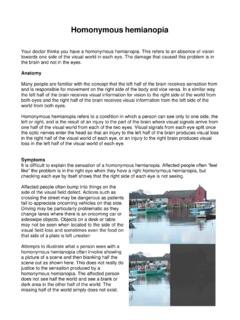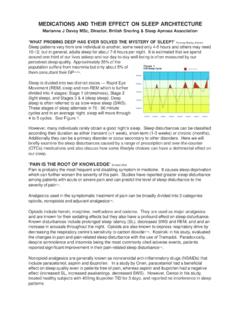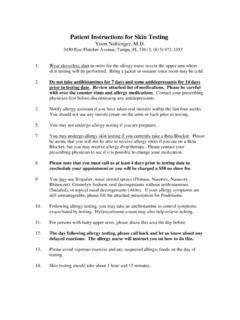Transcription of NANOS Patient Brochure - North American Neuro ...
1 NANOS Patient Brochure Dry Eye Syndrome Copyright 2016. North Ameri can Neuro -Ophthalmology Soc iety. All rights reserved. These brochures are produ ced and made ava ilabl e as is with out warranty and for informational and edu cational pu rposes only and do not constitute, and should not be used as a substitute fo r, medi cal advice, di agn os is, or treatment. Patient s and other members of the ge ner al public should always seek the advice of a ph ysician or other qu alified health care prof essional regarding personal health or medi cal conditions. 2 Dry Eye Syndrome Dry Eye Syndrome (DES) affects approximately 10% of people between the ages of 30 and 60 and 15% of adults over age 65. It is caused by an unhealthy tear film and can create many symptoms. While the condition can be mild, it can also be a significant problem that affects day-to-day living. There are many treatment options.
2 Your doctor will help you determine which treatment is best for you. Symptoms of Dry Eye Syndrome Dry Eye Syndrome can cause any of the following symptoms: Dry sensation Itching, burning, or scratchy sensation Sandy or gritty sensation Light sensitivity Sharp or achy pain in or around the eyes Redness Blurred or double vision Excessive tearing Any combination of these symptoms may be present. Often, the symptoms fluctuate from day to day, or even hour to hour. In mild cases, symptoms may be intermittent and tolerable, while in severe cases, the symptoms may be constant, severe, and very disruptive to daily activities. What are tears? Tears are a mixture of saltwater, mucous (mucin), and oil (lipid). These components form a smooth gel-like coat , called the tear film, on the surface of the eye. The tear film has many important functions: Moisturizes and protects the surface of the eye Washes away debris and germs Carries nutrients to the surface of the eye Contains proteins that prevent infection, control inflammation, and digest harmful proteins secreted by bacteria Acts as an important focusing surface for the eye An imbalance in the saltwater, mucous, or oil components can disrupt the tear film and cause Dry Eye Syndrome.
3 Why Are My Eyes Dry? There are a number of different factors that contribute to dry eyes: 3 Environmental factors Low humidity or air movement across the eye can increase evaporation of the tear film. This includes: Dry climate Use of a fireplace, heater, or air conditioner Windy conditions Car vents, hair dryers, and room/ceiling fans Leaky masks for sleep apnea Other environmental factors including dust, dirt, cigarette smoke, and pollution may worsen Dry Eye Syndrome. Medications Some medications can cause the eyes to be dry, including the following: Oral antihistamines (like Benadryl, or diphenhydramine) Antidepressants (like Elavil, or amitriptyline) Decongestants (like Sudafed, or pseudoephedrine) Hormone replacement therapy Additionally, some eye drops contain preservatives that can cause or worsen dry eye syndrome. You should speak with your doctor about any prescription medications you think may be contributing to Dry Eye Syndrome.
4 Eyelids and Blinking The eyelids spread the tear film evenly over the surface of the eye with every blink. Medical conditions and activities that can prevent lid closure or decrease blinking include: Thyroid disease Parkinson Disease Reading Computer work Watching TV Aging-related changes of the eyelids and scars following injury can also impair proper eyelid function. Medical Conditions Dry Eye Syndrome can be present in people with autoimmune disease or other systemic conditions, including the following: Diabetes mellitus Rosacea Sj gren syndrome Rheumatoid arthritis Systemic lupus erythematous Sarcoidosis 4 Ocular Conditions Contact lens wear, prior refractive surgery (like LASIK), and eye allergies can contribute to dry eyes. Hormonal Causes Women who are postmenopausal tend to have reduced tear secretion, even if taking hormone replacement (like estrogen).
5 Pregnant women tend to have increased tear secretion. The effect of estrogen replacement therapy on tear secretion is not completely understood. Treatment of dry eye There are many different treatments for dry eyes. Often, artificial tear drops alone are helpful. Regardless of the treatment method, a period of consistent use of 6-8 weeks may be necessary before any benefit is seen. The treatment may need to be continued to maintain the benefit, unless environmental or other causative factors are addressed. Artificial Tears Artificial tears are available over-the-counter and do not require a prescription. Your physician can help you choose among the many different brands and formulations. Experimentation with different types may be needed to find one that does the following: Feels soothing when placed on the eye Only momentarily blurs the vision Does not cause any burning or redness Some tears are thicker than others.
6 Although thicker tears last longer, they can blur vision for several minutes. Your physician will tell you how often to use the artificial tears, typically 4 times a day or more. Artificial Tears Ointment People with severe dry eyes will sometimes need to use an ointment. Ointment at bedtime is especially helpful if your eyes do not stay closed completely when you are sleeping, or if you have severe dry eye symptoms upon awakening. Ointments make the vision very blurry, so should be applied sparingly (about the size of a grain of rice) immediately before sleeping. Eyelid Soaks and Scrubs and Antibiotics Dry Eye Syndrome can be caused by the Meibomian glands that secrete oil into the tear film. The glands secretions may become decreased, increased, or too thick. Your physician may prescribe a regimen of warm soaks and eyelid scrubs multiple times a day to address these problems.
7 Sometimes an oral antibiotic such as doxycycline is helpful, especially in people with acne rosacea. Low doses of these medications are used not to treat an infection but to thin the meibomian gland secretions and help stabilize the tear film. 5 Anti-Inflammatories Physicians will sometimes prescribe anti-inflammatory eye drops to treat severe dry eyes. The most commonly prescribed medication for this condition is Restasis (cyclosporine). Restasis helps the body produce more tears and takes 2-3 months to begin to improve symptoms. Environmental Modification Use a humidifier during dry winter months Direct car air vents away from the face Avoid ceiling fans or air ducts Wear glasses in windy outdoor conditions Ensure CPAP mask fits securely without any air leakage Use an air purifying filter to reduce dust or other allergens that can worsen dry eye symptoms Dietary Supplementation Omega-3-fatty acids may improve symptoms from dry eye syndrome and associated eyelid inflammation.
8 Sources of Omega-3-fatty acids include fatty fish (salmon, sardines), walnuts, chia seeds and flaxseed. Fish oil or fatty oil supplements are also available. Individuals should speak with their eye care provider prior to starting supplementation. Punctal Plugs People with dry eye problems will sometimes have one or both of the puncta (see the diagram of tear drainage below) closed to increase the amount of tears on the eye surface. The plugs must be inserted by a physician and can be temporary or permanent. Physicians may also use a cautery tool to permanently close the puncta if the condition persists. Surgery Surgery may be necessary for scarred eyelids, eyelids that do not close completely, or eyelids that are not positioned correctly. Frequently Asked Questions How can I have dry eyes when my eyes water all the time? Excess watering or tearing is a common symptom of dry eyes and occurs in response to the eye irritation caused by dryness.
9 Treatment, including artificial tears, will calm the underlying irritation and eventually reduce the reflex tearing. I use artificial tears, but they don t seem to be helping. Am I doing something wrong? If artificial tears do not initially seem to help, they usually need to be used more often and for a longer period of time. Artificial tears must be used on a regular basis, usually several times a day, and for several weeks to improve dry eye symptoms. If symptoms persist after several weeks of frequent artificial tears, other treatments 6 may be needed. How does Dry Eye Syndrome cause blurry vision or double vision? The tear film is an important focusing surface for the eye. Dry Eye Syndrome can make this surface uneven or irregular, and can lead to problems with focusing. Blurry vision or double vision can then develop. Often, these visual symptoms occur while reading: The vision is clear at first but becomes blurry after reading for a few minutes.
10 Rest, wiping the eyes, or blinking temporarily clears the vision. A similar pattern of symptoms can occur while using the computer or watching television. If I am constantly producing tears, where do they all go? Just as tears are constantly being produced, they are constantly being drained off the surface of the eyes. With each blink, tears are pushed through tiny holes called puncta on the inner surface of the eyelid and into a tear drainage system. The structures that produce the layers of the tear film must keep up with this constant drainage. This figure shows the tear production and drainage systems of the left eye. The aqueous component of the tear film is made by the lacrimal gland. It sits just above the eye, behind the eyelid, within the eye socket. Mucin and lipid are produced by glands on the surface of the eye and on the eyelid margin.
